
One Week in Berlin & Prague: See the Highlights and Experience the Local Scene
 7 Day Tour of Berlin and Prague
7 Day Tour of Berlin and Prague
Overview
Trip Map
Itinerary
Inclusions
Reviews







7 Days 6 Nights
Best Time: Jan-Dec
Cultural Exploration
Experiencing the Local Scene
Dive into the heart of Central Europe with a 7-day Berlin and Prague itinerary, where history and culture intertwine with a modern and vibrant local scene. In Berlin, witness the monumental Brandenburg Gate and the poignant Checkpoint Charlie, capturing the essence of a city reborn from its divided past. Your journey continues in Prague, a fairy-tale city where the Vltava River gracefully meanders. Enjoy an enchanting river cruise beneath Gothic and Baroque splendors. Learn the secrets of each city through two private guided tours with locals, and benefit from detailed travel guidance, ensuring an insightful and stress-free trip.
- Walk the glass dome of the Reichstag in Berlin, a symbol of Germany's democratic rebirth
- Stroll through Berlin's Hackesche Höfe, a labyrinth of beautiful courtyards
- Spend evenings in neighborhoods loved by locals, such as Kreuzberg in Berlin and Žižkov in Prague
- Explore the majestic Prague Castle, a storied symbol of Czech heritage overlooking the city
- Take in stunning romantic views of Prague from the historic Charles Bridge
Dive into the heart of Central Europe with a 7-day Berlin and Prague itinerary, where history and culture intertwine with a modern and vibrant local scene. In Berlin, witness the monumental Brandenburg Gate and the poignant Checkpoint Charlie, capturing the essence of a city reborn from its divided past. Your journey continues in Prague, a fairy-tale city where the Vltava River gracefully meanders. Enjoy an enchanting river cruise beneath Gothic and Baroque splendors. Learn the secrets of each city through two private guided tours with locals, and benefit from detailed travel guidance, ensuring an insightful and stress-free trip.
- Walk the glass dome of the Reichstag in Berlin, a symbol of Germany's democratic rebirth
- Stroll through Berlin's Hackesche Höfe, a labyrinth of beautiful courtyards
- Spend evenings in neighborhoods loved by locals, such as Kreuzberg in Berlin and Žižkov in Prague
- Explore the majestic Prague Castle, a storied symbol of Czech heritage overlooking the city
- Take in stunning romantic views of Prague from the historic Charles Bridge

The Brandenburg Gate
Historic Landmarks

The Berlin Wall
Historic Landmarks

Checkpoint Charlie
European History

Prague Castle
Castles & Chateaux

Charles Bridge
Historic Landmarks

Wenceslas Square
European History
Must see sights

The Brandenburg Gate
Historic Landmarks

The Berlin Wall
Historic Landmarks

Checkpoint Charlie
European History

Prague Castle
Castles & Chateaux

Charles Bridge
Historic Landmarks

Wenceslas Square
European History
Starting from
$1495
per person
 Not included
Not included Secure Your Customizable Trip
Enter your details to embark on a journey that can be tailored just for you.
Start
Travelers
0 travelers
Add Room
Remove Room
Preferred Hotel Stars
Select Hotel Stars
Craft Your Own Itinerary
Select your interests and destinations for a trip plan inspired by you.
Trip Map & Itinerary
Enable/Disable Map Scrolling
Click To Make Map Interactive

Trip Timeline
 Edit Details
Edit DetailsArrival
2 nights
Berlin
Germany
Train: 4.5h
4 nights
Prague
Czech Republic
Departure
Day-By-Day Itinerary
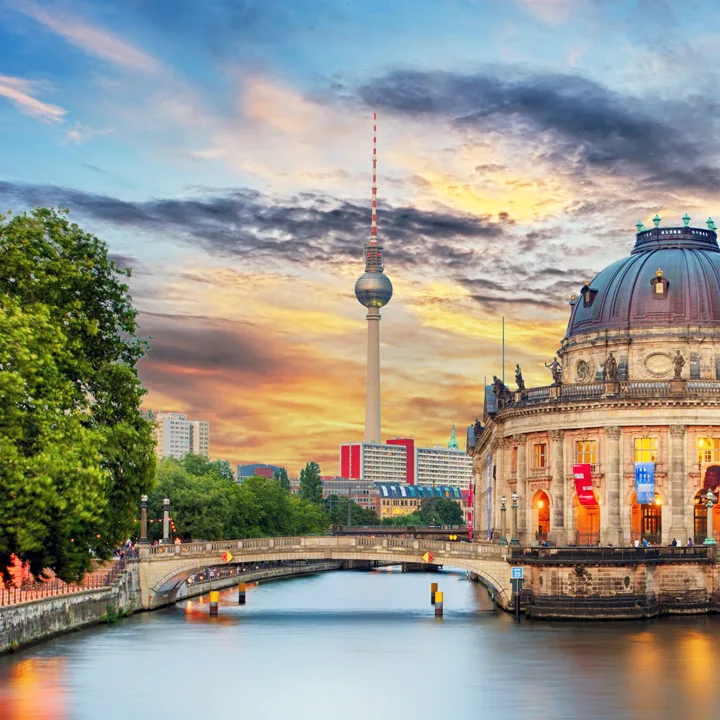
Day 1
Arrive Berlin
View More
Day 1
Arrive Berlin



To Be Determined
Airport Transfer by Taxi or Train
Flying into Berlin you will arrive in the brand new Berlin Brandenburg Airport to the south of the city. Taxis are available at the airport, or you can arrange a private transfer for added convenience. The cheapest and fastest way to reach central Berlin is by train. The Airport Express train delivers you to Berlin's main station (Hauptbahnhof) in the center of the city, from where you can easily hail a taxi.

Day 1
Arrive Berlin
View More


Day 1
Arrive Berlin




To Be Determined:
Airport Transfer
Mid-Day/Afternoon:
TV Tower & Old Berlin
Late Afternoon/Early Evening:
Courtyards of Berlin


Day 2
Berlin
View More
Day 2
Berlin




9:00 AM - 12:00 PM
Highlights of Berlin Guided Walking Tour
On this 3 hour tour, your guide will show you the highlights of Berlin and help you understand what makes this city so unique. Sites visited will include the boulevard Unter den Linden, the Gendarmenmarkt, Check Point Charlie, remnants of the Berlin Wall, Potsdamer Platz, the Holocaust Memorial, the Brandenburg Gate, and the Reichstag.

Brandenburg Gate
Quadriga. Hey, There's a Word to Know When Learning About this Historic Gate
Show More

Reichstag
Make your way to the top of the dome enjoying amazing views and looking down at debating members of the German Parliament below.
Show More

Brandenburg Gate
Quadriga. Hey, There's a Word to Know When Learning About this Historic Gate
Show More

Reichstag
Make your way to the top of the dome enjoying amazing views and looking down at debating members of the German Parliament below.
Show More

Brandenburg Gate
Quadriga. Hey, There's a Word to Know When Learning About this Historic Gate
Show More

Reichstag
Make your way to the top of the dome enjoying amazing views and looking down at debating members of the German Parliament below.
Show More
prev
next

Day 2
Berlin
View More

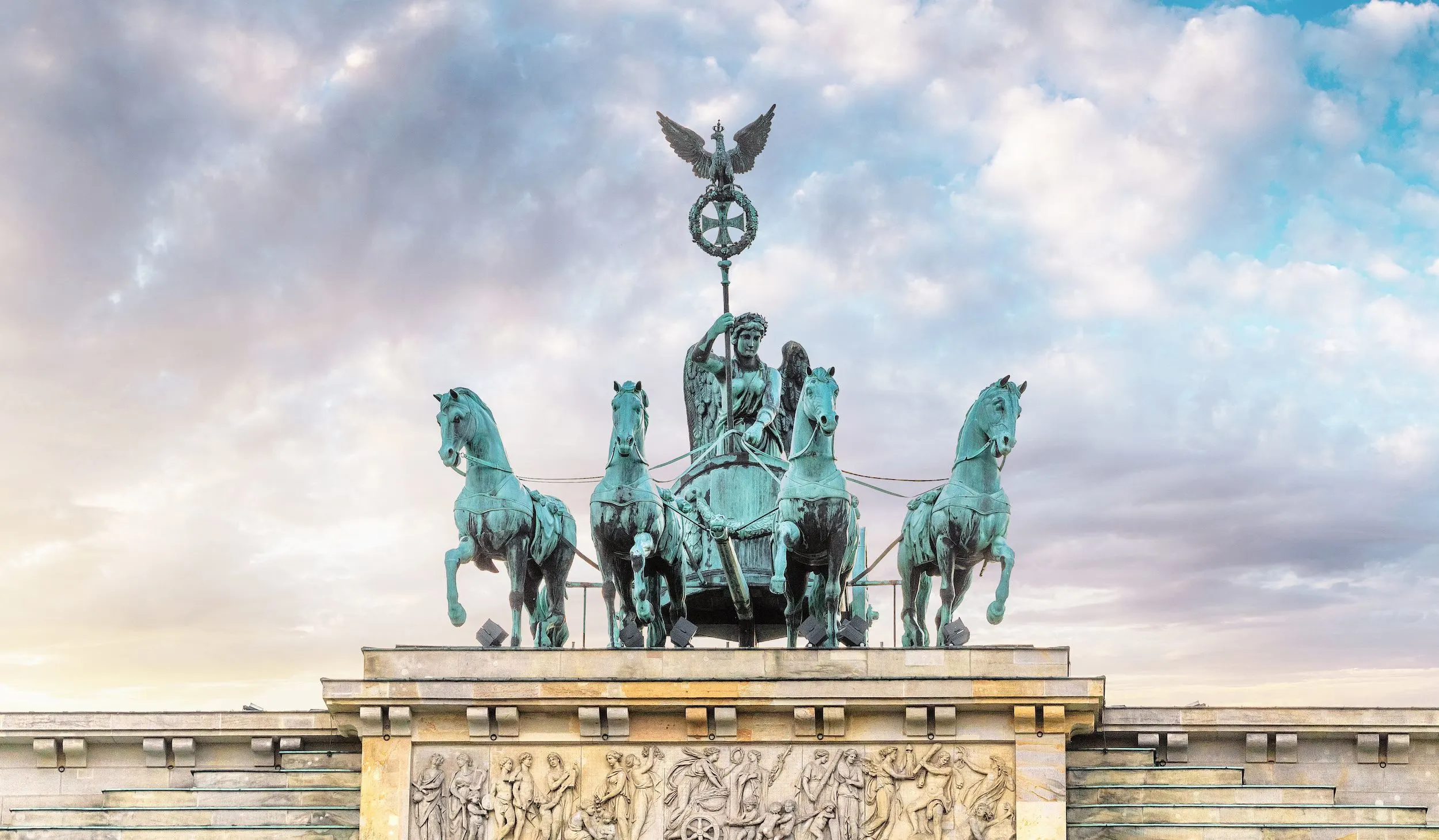
Brandenburg Gate
 Highlight of Guided Walking Tour of Berlin
Highlight of Guided Walking Tour of BerlinQuadriga. Hey, There's a Word to Know When Learning About this Historic Gate
The Brandenburg Gate was built as a symbol of peace, perverted into a symbol of power by the Nazis, and became a symbol of division during the Cold War. Now, however, it is a symbol of reunification. Completed in 1791, it was topped by the quadriga, a chariot drawn by four horses driven by the goddess of peace. Napoleon seized the quadriga as a spoil of war, but after his defeat, it was returned to the city and met by cheering crowds along the way, transforming the goddess of peace into a goddess of victory, holding a Germanic cross.

Reichstag
 Highlight of Guided Walking Tour of Berlin
Highlight of Guided Walking Tour of BerlinMake your way to the top of the dome enjoying amazing views and looking down at debating members of the German Parliament below.
Officially, the Reichstag is actually the Bundestag, which means the federal parliament. The Reichstag was reduced to a ruined shell by arson in 1933 and by World War II fighting, but it was rebuilt with a striking egg-shaped glass dome. Visitors are given a free audio guide that discusses the building’s history and architecture, while also orientating you to the sites of Berlin. It is an excellent introduction to the city. Note that it is usually necessary to book well in advance!

Brandenburg Gate
 Highlight of Guided Walking Tour of Berlin
Highlight of Guided Walking Tour of BerlinQuadriga. Hey, There's a Word to Know When Learning About this Historic Gate
The Brandenburg Gate was built as a symbol of peace, perverted into a symbol of power by the Nazis, and became a symbol of division during the Cold War. Now, however, it is a symbol of reunification. Completed in 1791, it was topped by the quadriga, a chariot drawn by four horses driven by the goddess of peace. Napoleon seized the quadriga as a spoil of war, but after his defeat, it was returned to the city and met by cheering crowds along the way, transforming the goddess of peace into a goddess of victory, holding a Germanic cross.

Reichstag
 Highlight of Guided Walking Tour of Berlin
Highlight of Guided Walking Tour of BerlinMake your way to the top of the dome enjoying amazing views and looking down at debating members of the German Parliament below.
Officially, the Reichstag is actually the Bundestag, which means the federal parliament. The Reichstag was reduced to a ruined shell by arson in 1933 and by World War II fighting, but it was rebuilt with a striking egg-shaped glass dome. Visitors are given a free audio guide that discusses the building’s history and architecture, while also orientating you to the sites of Berlin. It is an excellent introduction to the city. Note that it is usually necessary to book well in advance!

Brandenburg Gate
 Highlight of Guided Walking Tour of Berlin
Highlight of Guided Walking Tour of BerlinQuadriga. Hey, There's a Word to Know When Learning About this Historic Gate
The Brandenburg Gate was built as a symbol of peace, perverted into a symbol of power by the Nazis, and became a symbol of division during the Cold War. Now, however, it is a symbol of reunification. Completed in 1791, it was topped by the quadriga, a chariot drawn by four horses driven by the goddess of peace. Napoleon seized the quadriga as a spoil of war, but after his defeat, it was returned to the city and met by cheering crowds along the way, transforming the goddess of peace into a goddess of victory, holding a Germanic cross.

Reichstag
 Highlight of Guided Walking Tour of Berlin
Highlight of Guided Walking Tour of BerlinMake your way to the top of the dome enjoying amazing views and looking down at debating members of the German Parliament below.
Officially, the Reichstag is actually the Bundestag, which means the federal parliament. The Reichstag was reduced to a ruined shell by arson in 1933 and by World War II fighting, but it was rebuilt with a striking egg-shaped glass dome. Visitors are given a free audio guide that discusses the building’s history and architecture, while also orientating you to the sites of Berlin. It is an excellent introduction to the city. Note that it is usually necessary to book well in advance!
prev
next

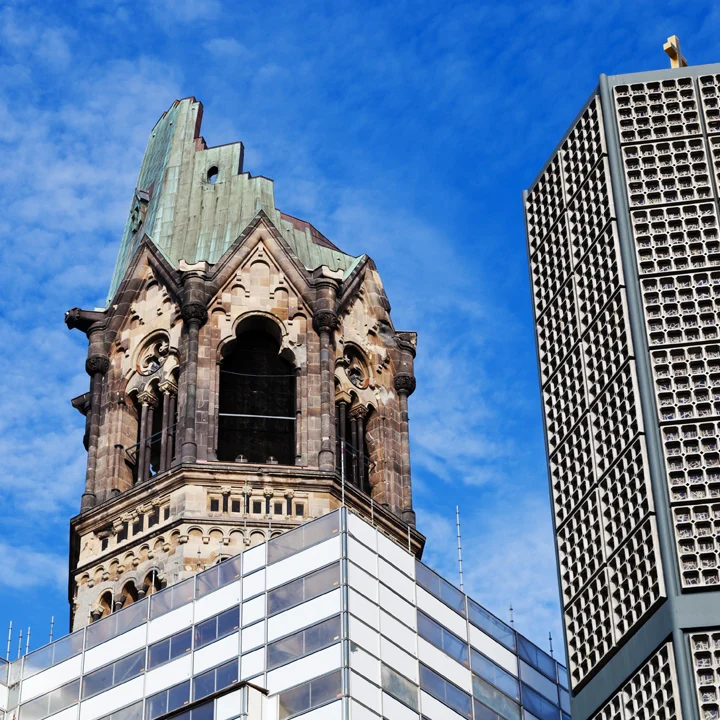
Day 3
Berlin to Prague
View More
Day 3
Berlin to Prague





Morning/Mid-Day
Stroll the Kurfürstendamm in West Berlin
In the 1920's the elegant, tree-line boulevard known as the Kurfürstendamm was the center of Berlin's nightlife and leisure scene, attracting writers, film stars, and artists. WWII left it in ruins, and today at the end of the boulevard you'll discover a chilling reminder of that destruction: the purposefully unrecontructed remains of the Memorial Church. During the Cold War, the Kurfürstendamm and its surroundings were central to West Berlin's revitalized identity. This was perhaps best symbolized by the famous KaDeWe, the gigantic department store which served as a symbol of market capitalism lodged in the heart of the Iron Curtain.

Berlin Zoo
Visit Germany's Oldest and Best Known Zoo.
Show More

KaDeWe
Shop in the iconic department store of capitalist West Berlin
Show More

Memorial Church
Remind yourself of war's destructiveness by visiting the ruins of this church destroyed during WWII.
Show More

Story of Berlin Museum
Take an interactive crash course in Berlin history. (Re-opening Autumn 2021)
Show More

Berlin Zoo
Visit Germany's Oldest and Best Known Zoo.
Show More

KaDeWe
Shop in the iconic department store of capitalist West Berlin
Show More

Memorial Church
Remind yourself of war's destructiveness by visiting the ruins of this church destroyed during WWII.
Show More

Story of Berlin Museum
Take an interactive crash course in Berlin history. (Re-opening Autumn 2021)
Show More
prev
next

Day 3
Berlin to Prague
View More

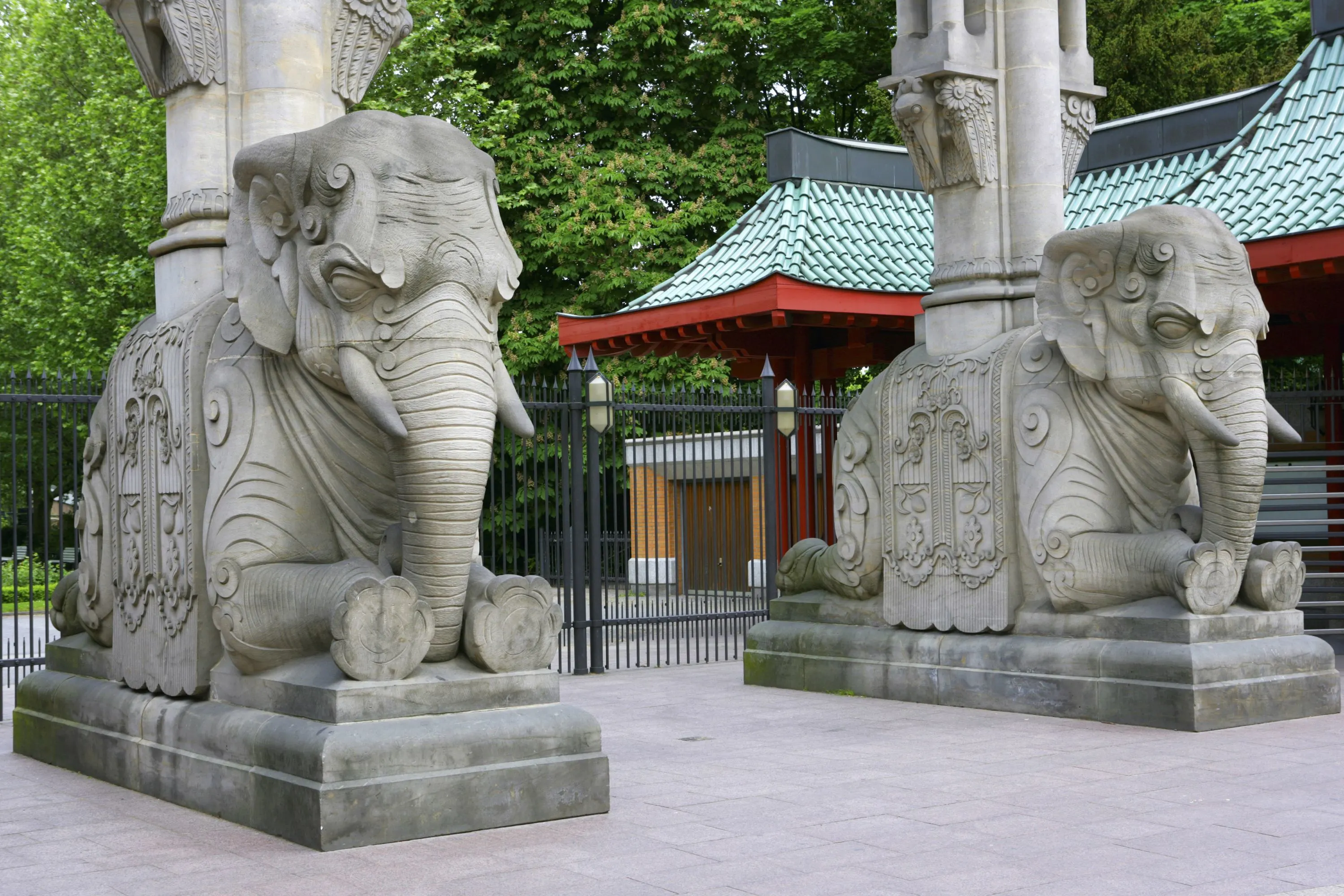
Berlin Zoo
 Highlight of City West
Highlight of City WestVisit Germany's Oldest and Best Known Zoo.
Founded in 1844, the Zoologischer Garten Berlin was the first zoo in Germany and features some wonderful animal-inspired architecture as well. The original animals were donated by King Frederick William IV of Prussia, and it now has a collection of around 20,500 animals representing 1,500 different species. The zoo’s aquarium opened in 1913 and now contains one of the largest collections of aquatic life in Europe.
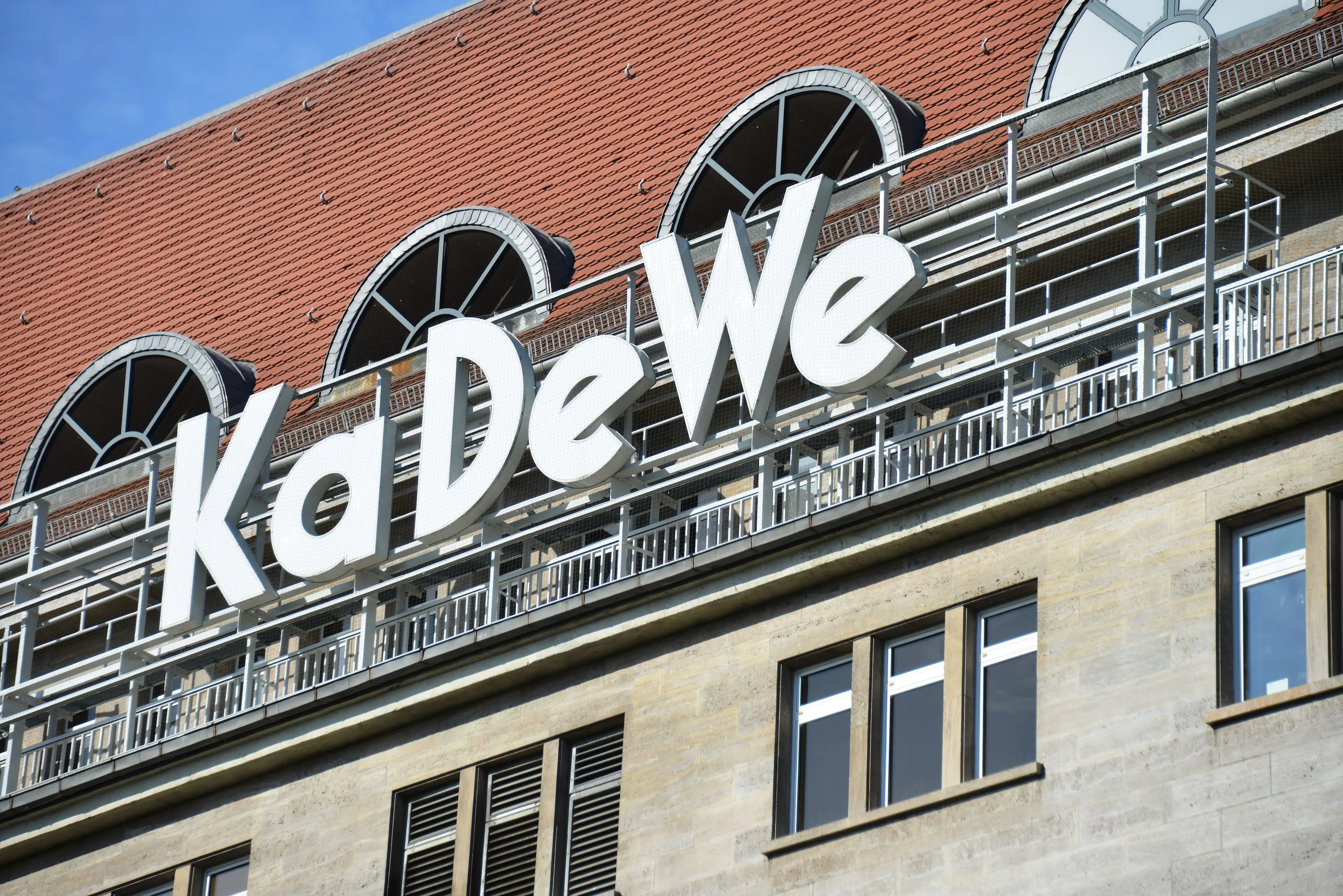
KaDeWe
 Highlight of City West
Highlight of City WestShop in the iconic department store of capitalist West Berlin
Opened in 1907, the Kaufhaus des Westens, or KaDeWe, quickly became a temple of luxury in a rapidly modernising city. It took off again following the German post-war economic miracle and gained new impetus again following German reunification. During Communism, due to it's proximity to East Germany, it became a symbol of the material wealth of the West in comparison to that of countries stuck behind the Iron Curtain.

Memorial Church
 Highlight of City West
Highlight of City WestRemind yourself of war's destructiveness by visiting the ruins of this church destroyed during WWII.
After its destruction in WWII, the Kaiser Wilhelm Memorial Church was partially rebuilt in modernist style, and partially left in ruins as a powerful reminder of the war. Built-in the 1890s, Kaiser Wilhelm II hoped to inspire the secular proletariat to return to traditional religious values. The neo-Gothic design became ever more colorful as Wilhelm insisted on more bling. The small exhibition inside shows the wartime destruction and a “before and after” model of the city center.
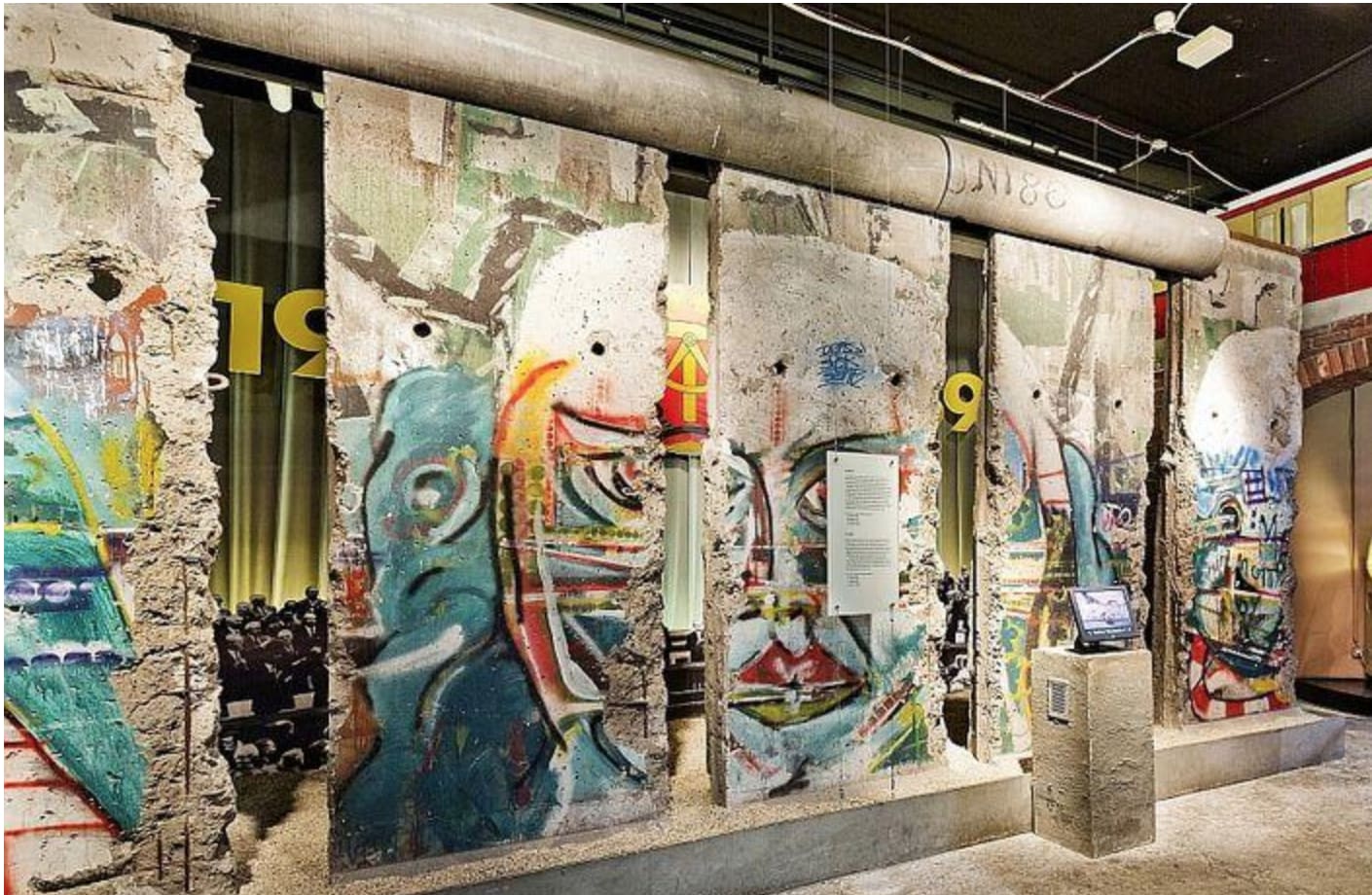
Story of Berlin Museum
 Highlight of City West
Highlight of City WestTake an interactive crash course in Berlin history. (Re-opening Autumn 2021)
This museum uses reconstructed street scapes, homes, and other interactive exibits to give you good feeling for the atmosphere of Berlin during it's long and often times turbulent history, including during the Nazi and Communist era. You can also tour an underground nuclear shelter.

Berlin Zoo
 Highlight of City West
Highlight of City WestVisit Germany's Oldest and Best Known Zoo.
Founded in 1844, the Zoologischer Garten Berlin was the first zoo in Germany and features some wonderful animal-inspired architecture as well. The original animals were donated by King Frederick William IV of Prussia, and it now has a collection of around 20,500 animals representing 1,500 different species. The zoo’s aquarium opened in 1913 and now contains one of the largest collections of aquatic life in Europe.

KaDeWe
 Highlight of City West
Highlight of City WestShop in the iconic department store of capitalist West Berlin
Opened in 1907, the Kaufhaus des Westens, or KaDeWe, quickly became a temple of luxury in a rapidly modernising city. It took off again following the German post-war economic miracle and gained new impetus again following German reunification. During Communism, due to it's proximity to East Germany, it became a symbol of the material wealth of the West in comparison to that of countries stuck behind the Iron Curtain.

Memorial Church
 Highlight of City West
Highlight of City WestRemind yourself of war's destructiveness by visiting the ruins of this church destroyed during WWII.
After its destruction in WWII, the Kaiser Wilhelm Memorial Church was partially rebuilt in modernist style, and partially left in ruins as a powerful reminder of the war. Built-in the 1890s, Kaiser Wilhelm II hoped to inspire the secular proletariat to return to traditional religious values. The neo-Gothic design became ever more colorful as Wilhelm insisted on more bling. The small exhibition inside shows the wartime destruction and a “before and after” model of the city center.

Story of Berlin Museum
 Highlight of City West
Highlight of City WestTake an interactive crash course in Berlin history. (Re-opening Autumn 2021)
This museum uses reconstructed street scapes, homes, and other interactive exibits to give you good feeling for the atmosphere of Berlin during it's long and often times turbulent history, including during the Nazi and Communist era. You can also tour an underground nuclear shelter.
prev
next


Day 4
Prague
View More
Day 4
Prague




9:00 AM - 12:30 PM
Prague Castle & Royal Route Guided Walk
On this charming guided walk, you will explore the Prague Castle, the largest castle complex in all of Europe. To reach the castle you will trace the Royal Coronation Route and cross the Charles Bridge, whose “speaking stones” reveal the amazing and often cruel history that occurred there. Your tour guide will then take you either through the castle courtyards and into the dramatic St. Vitus Cathedral in the center of the castle complex, or through the upper part of the castle district around the oversized palaces of the old Catholic nobility and the top of the Castle Steps for incomparable views over the red rooftops of the Little Quarter.

Charles Bridge
Cross the river dividing Prague's most historic neighborhoods, and experience one of Europe's most iconic landmarks.
Show More

Maltese Square & Lennon Wall
See a historic wall that has been covered in John Lennon-inspired graffiti since Communist days.
Show More

Prague Castle
Prague Castle is one of the main attractions in Prague and is also the largest castle complex in the world.
Show More

Charles Bridge
Cross the river dividing Prague's most historic neighborhoods, and experience one of Europe's most iconic landmarks.
Show More

Maltese Square & Lennon Wall
See a historic wall that has been covered in John Lennon-inspired graffiti since Communist days.
Show More

Prague Castle
Prague Castle is one of the main attractions in Prague and is also the largest castle complex in the world.
Show More

Charles Bridge
Cross the river dividing Prague's most historic neighborhoods, and experience one of Europe's most iconic landmarks.
Show More
prev
next

Day 4
Prague
View More

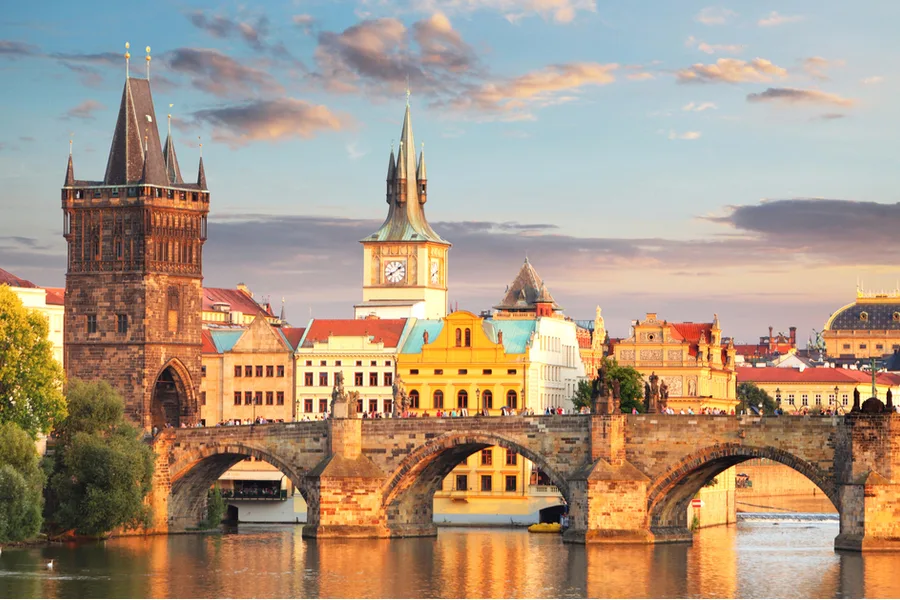
Charles Bridge
 Highlight of Royal Route Guided Tour
Highlight of Royal Route Guided TourCross the river dividing Prague's most historic neighborhoods, and experience one of Europe's most iconic landmarks.
Bridge construction began in 1357 under King Charles IV (hence the name), and it was the only bridge across the Vltava River until 1841. 30 baroque statues of saints line the bridge, and it is filled with street artists and entertainers. Not to be missed.

Maltese Square & Lennon Wall
 Highlight of Royal Route Guided Tour
Highlight of Royal Route Guided TourSee a historic wall that has been covered in John Lennon-inspired graffiti since Communist days.
The wall has been covered in graffiti since the 1960s, and during Communism anti-regime sentiment was common. John Lennon's assassination inspired grafitti reflecting his song, Imagine, which earned the wall its current moniker. It is now a favorite gathering place for tourists, and musicians sometimes congregate there as well. Just around the corner is the Maltese Square, which is one of Prague's more quaint and relaxed public spaces, despite being just off the main tourist route.

Prague Castle
 Highlight of Royal Route Guided Tour
Highlight of Royal Route Guided TourPrague Castle is one of the main attractions in Prague and is also the largest castle complex in the world.
The Prague Castle is the largest castle complex in the world with structures dating back to the 9th century. The St Vitus Cathedral and Basilica of St George can be found within the castle walls. The Prague Castle also includes several gardens, palaces, and a monastery. This castle was the seat of power for the Kings of Bohemia, Holy Roman Emperors, and presidents of former Czechoslovakia. Prague Castle is a UNESCO world heritage site and is one of the most visited places in the country.

Charles Bridge
 Highlight of Royal Route Guided Tour
Highlight of Royal Route Guided TourCross the river dividing Prague's most historic neighborhoods, and experience one of Europe's most iconic landmarks.
Bridge construction began in 1357 under King Charles IV (hence the name), and it was the only bridge across the Vltava River until 1841. 30 baroque statues of saints line the bridge, and it is filled with street artists and entertainers. Not to be missed.

Maltese Square & Lennon Wall
 Highlight of Royal Route Guided Tour
Highlight of Royal Route Guided TourSee a historic wall that has been covered in John Lennon-inspired graffiti since Communist days.
The wall has been covered in graffiti since the 1960s, and during Communism anti-regime sentiment was common. John Lennon's assassination inspired grafitti reflecting his song, Imagine, which earned the wall its current moniker. It is now a favorite gathering place for tourists, and musicians sometimes congregate there as well. Just around the corner is the Maltese Square, which is one of Prague's more quaint and relaxed public spaces, despite being just off the main tourist route.

Prague Castle
 Highlight of Royal Route Guided Tour
Highlight of Royal Route Guided TourPrague Castle is one of the main attractions in Prague and is also the largest castle complex in the world.
The Prague Castle is the largest castle complex in the world with structures dating back to the 9th century. The St Vitus Cathedral and Basilica of St George can be found within the castle walls. The Prague Castle also includes several gardens, palaces, and a monastery. This castle was the seat of power for the Kings of Bohemia, Holy Roman Emperors, and presidents of former Czechoslovakia. Prague Castle is a UNESCO world heritage site and is one of the most visited places in the country.

Charles Bridge
 Highlight of Royal Route Guided Tour
Highlight of Royal Route Guided TourCross the river dividing Prague's most historic neighborhoods, and experience one of Europe's most iconic landmarks.
Bridge construction began in 1357 under King Charles IV (hence the name), and it was the only bridge across the Vltava River until 1841. 30 baroque statues of saints line the bridge, and it is filled with street artists and entertainers. Not to be missed.
prev
next

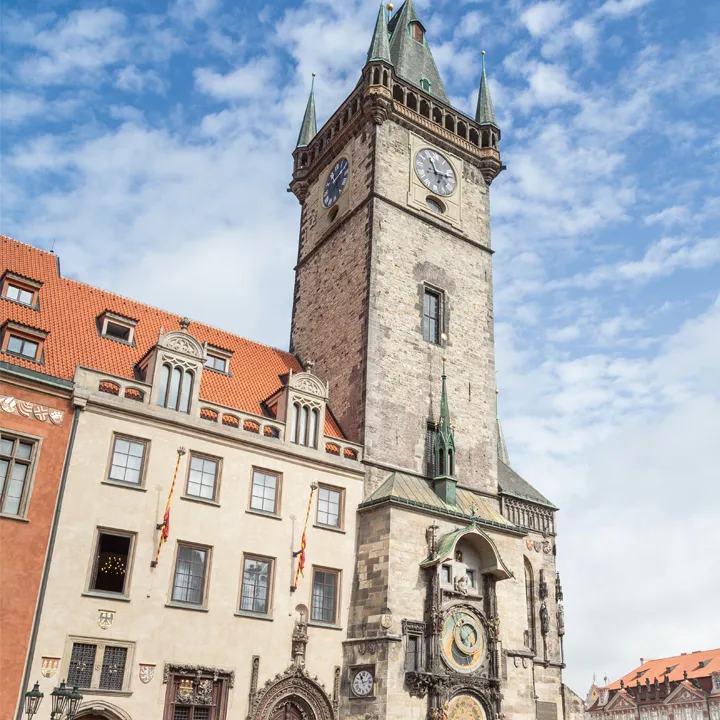
Day 5
Prague
View More
Day 5
Prague




Morning/Mid-Day
Wanderings in the Old Town
A visit to the Old Town transports you to an entirely different era. A labyrinth of twisting cobblestone lanes and alleys surrounds Old Town Square, which has been Prague's municipal center since the Middle Ages. The square is lined by magnificent churches and imposing Renaissance palaces. As you wander through the Old Town, you discover numerous other delights, including several beautiful churches, a plentiful supply of cozy cafes and pubs, and an outdoor market dating back to the Middle Ages.

Church of Our Lady before Týn
Count the spires on the Church of Our Lady Týn before discovering the hidden courtyard behind it.
Show More

Clementinum
Discover a large historical complex of buildings and courtyards "hidden in plain sight" within the Old Town.
Show More

Old Town Square
Make sure to visit one of Europe's most important, historic, and stunning city squares.
Show More

Old Town Hall and Astronomical Clock
See Prague's most photographed moment when the late medieval timepiece constructed on the side of the Old Town Hall Tower comes to life at the top of the hour.
Show More

Church of Our Lady before Týn
Count the spires on the Church of Our Lady Týn before discovering the hidden courtyard behind it.
Show More

Clementinum
Discover a large historical complex of buildings and courtyards "hidden in plain sight" within the Old Town.
Show More

Old Town Square
Make sure to visit one of Europe's most important, historic, and stunning city squares.
Show More

Old Town Hall and Astronomical Clock
See Prague's most photographed moment when the late medieval timepiece constructed on the side of the Old Town Hall Tower comes to life at the top of the hour.
Show More
prev
next

Day 5
Prague
View More

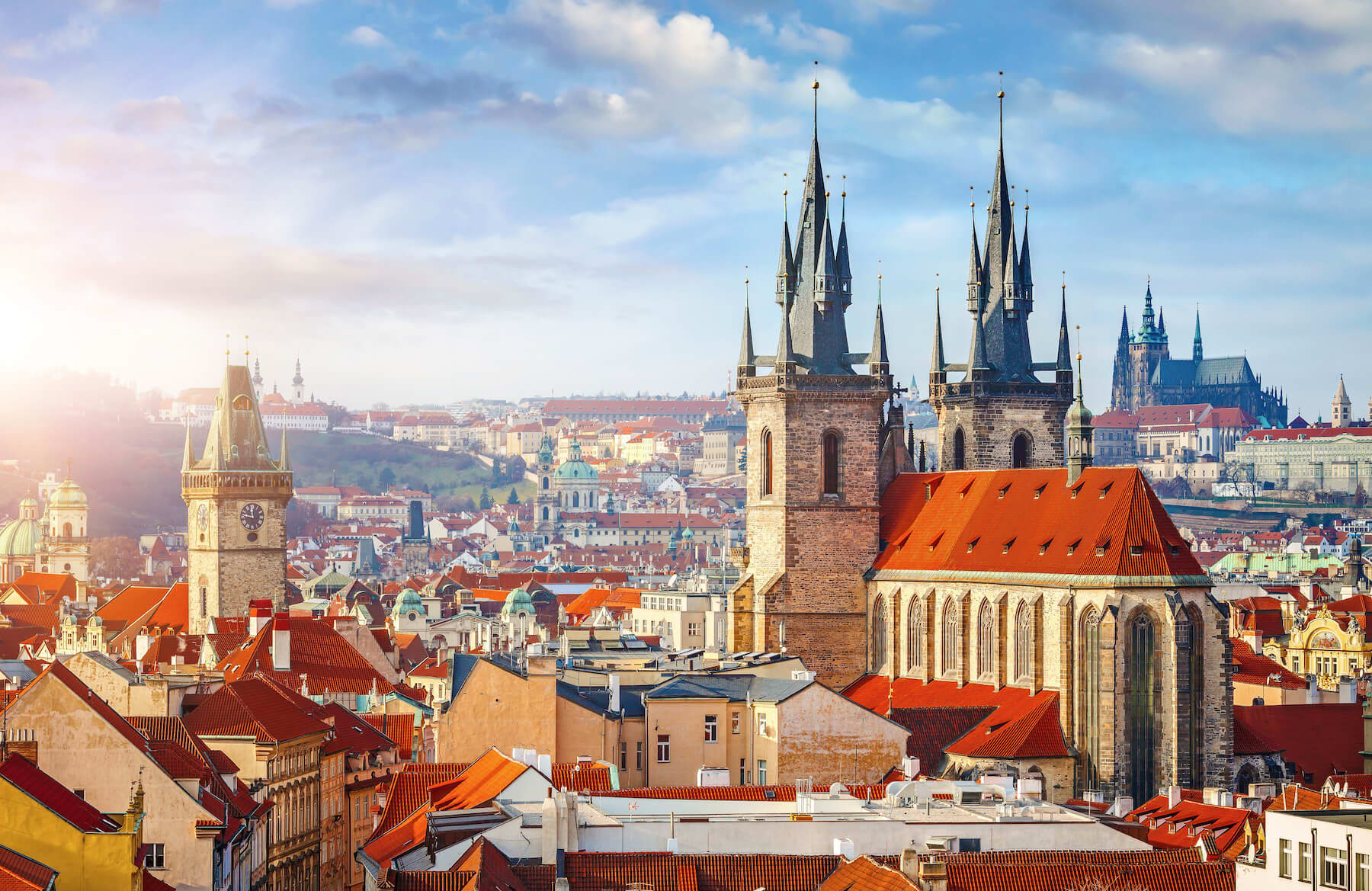
Church of Our Lady before Týn
 Highlight of Old Town
Highlight of Old TownCount the spires on the Church of Our Lady Týn before discovering the hidden courtyard behind it.
The 14th-century, Gothic church is a stunning structure with asymmetrical towers (note that the one on the right is slightly larger than the one on the left). It is the dominant feature of Old Town square and serves as an extensive gallery of Gothic, Renaissance and Early Baroque works. The church is the final resting place for the great astronomer Tycho Brahe.

Clementinum
 Highlight of Old Town
Highlight of Old TownDiscover a large historical complex of buildings and courtyards "hidden in plain sight" within the Old Town.
Founded as an abbey in the 11th century and later transformed into a Jesuit university, it is the second largest complex of buildings in Prague after the castle and contains four separate churches. Guided tours begin at 10am, and include an awe-inspiring Baroque library hall and the Astronomical Tower, from which you have a beautiful view of the Old Town.
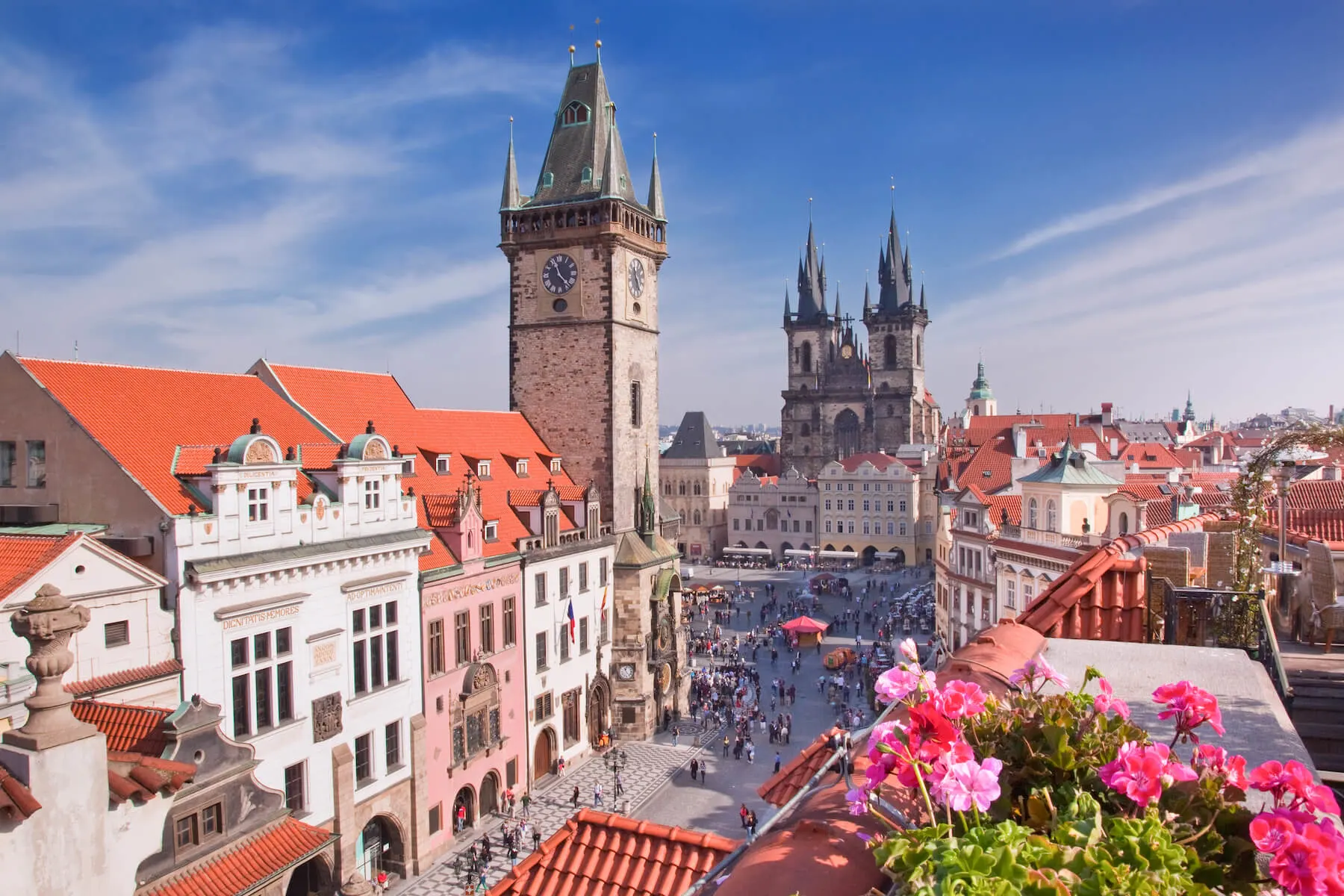
Old Town Square
 Highlight of Old Town
Highlight of Old TownMake sure to visit one of Europe's most important, historic, and stunning city squares.
The square is filled with rich history and surrounded by many beautiful old buildings, such as the gothic church of Our Lady before Týn and the baroque church of St. Nicholas. At the center of the square is a large statue of Jan Hus, a church reformer burnt at the stake in 1415, and a lovely and recently-restored column topped by the Virgin Mary. Today the square is filled with street performers, food stalls, and horse-drawn carriages.

Old Town Hall and Astronomical Clock
 Highlight of Old Town
Highlight of Old TownSee Prague's most photographed moment when the late medieval timepiece constructed on the side of the Old Town Hall Tower comes to life at the top of the hour.
Apostles proceed from the tower’s 1410 astronomical clock hourly, flanked by figures representing vanity, greed, death, and pleasure. You can also take an elevator to the top of the Old Town Hall tower for a great view of the Old Town Square and rooftops. Tours of the town hall and its gothic cellars are also offered.

Church of Our Lady before Týn
 Highlight of Old Town
Highlight of Old TownCount the spires on the Church of Our Lady Týn before discovering the hidden courtyard behind it.
The 14th-century, Gothic church is a stunning structure with asymmetrical towers (note that the one on the right is slightly larger than the one on the left). It is the dominant feature of Old Town square and serves as an extensive gallery of Gothic, Renaissance and Early Baroque works. The church is the final resting place for the great astronomer Tycho Brahe.

Clementinum
 Highlight of Old Town
Highlight of Old TownDiscover a large historical complex of buildings and courtyards "hidden in plain sight" within the Old Town.
Founded as an abbey in the 11th century and later transformed into a Jesuit university, it is the second largest complex of buildings in Prague after the castle and contains four separate churches. Guided tours begin at 10am, and include an awe-inspiring Baroque library hall and the Astronomical Tower, from which you have a beautiful view of the Old Town.

Old Town Square
 Highlight of Old Town
Highlight of Old TownMake sure to visit one of Europe's most important, historic, and stunning city squares.
The square is filled with rich history and surrounded by many beautiful old buildings, such as the gothic church of Our Lady before Týn and the baroque church of St. Nicholas. At the center of the square is a large statue of Jan Hus, a church reformer burnt at the stake in 1415, and a lovely and recently-restored column topped by the Virgin Mary. Today the square is filled with street performers, food stalls, and horse-drawn carriages.

Old Town Hall and Astronomical Clock
 Highlight of Old Town
Highlight of Old TownSee Prague's most photographed moment when the late medieval timepiece constructed on the side of the Old Town Hall Tower comes to life at the top of the hour.
Apostles proceed from the tower’s 1410 astronomical clock hourly, flanked by figures representing vanity, greed, death, and pleasure. You can also take an elevator to the top of the Old Town Hall tower for a great view of the Old Town Square and rooftops. Tours of the town hall and its gothic cellars are also offered.
prev
next

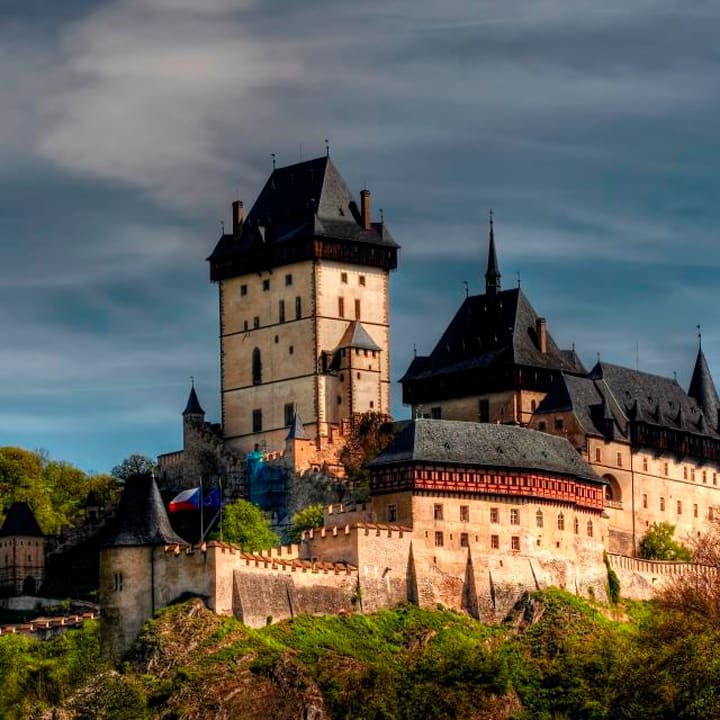
Day 6
Prague
View More
Day 6
Prague



Morning to Afternoon
Excursion by Train to Karlštejn Castle
Karlštejn, i.e. Charles' Stone Castle, is the most famous castle in the Czech Republic. The fairy-tale perfect castle was founded by King Charles IV in 1348 to guard his royal treasures. It's massive towers and walls are spread out over a series of rocky peaks above the Berounka River and commands striking views of the surrounding hills.

Chapel of the Holy Rood
Tour a closely-guarded and jewel-encrusted chapel decorated with amazing medieval art.
Show More

Chapel of the Holy Rood
Tour a closely-guarded and jewel-encrusted chapel decorated with amazing medieval art.
Show More

Chapel of the Holy Rood
Tour a closely-guarded and jewel-encrusted chapel decorated with amazing medieval art.
Show More

Chapel of the Holy Rood
Tour a closely-guarded and jewel-encrusted chapel decorated with amazing medieval art.
Show More

Chapel of the Holy Rood
Tour a closely-guarded and jewel-encrusted chapel decorated with amazing medieval art.
Show More
prev
next

Day 6
Prague
View More

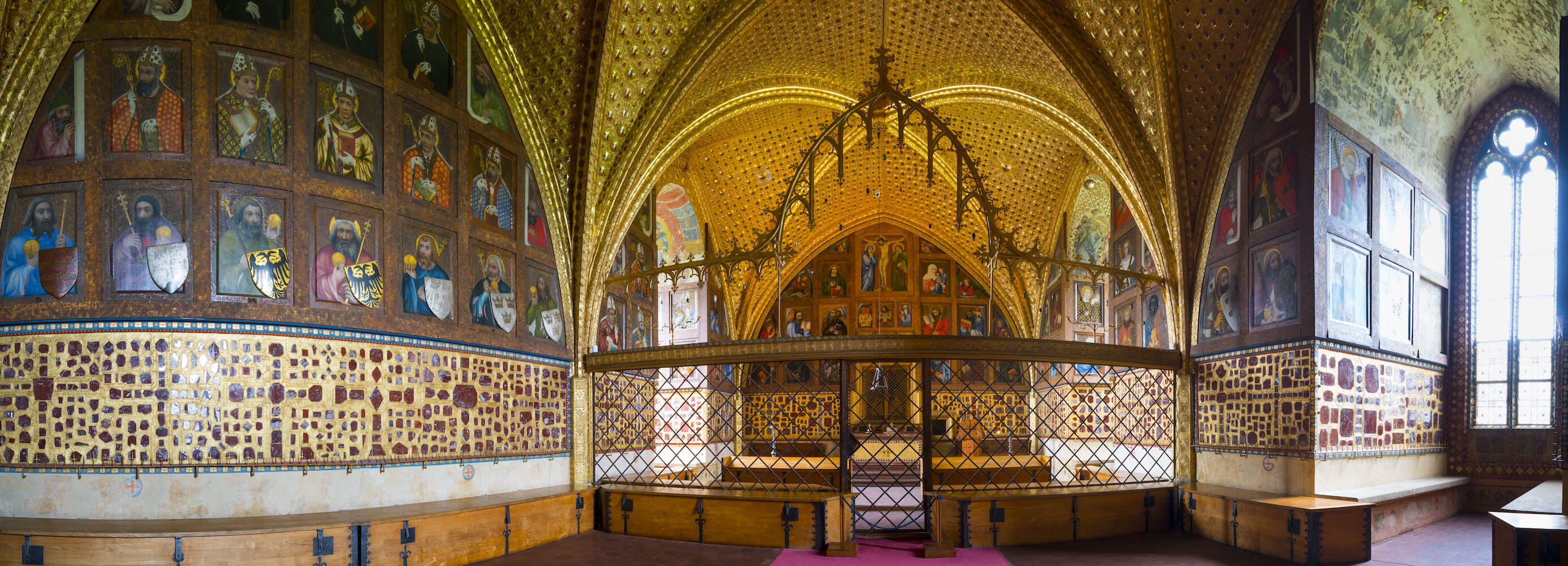
Chapel of the Holy Rood
 Highlight of Karlštejn Castle
Highlight of Karlštejn CastleTour a closely-guarded and jewel-encrusted chapel decorated with amazing medieval art.
The most important and impressive part of the castle, the Chapel of the Holy Rood, is open only to special guided tours due to the fact that its walls are literally covered in precious jewels.

Chapel of the Holy Rood
 Highlight of Karlštejn Castle
Highlight of Karlštejn CastleTour a closely-guarded and jewel-encrusted chapel decorated with amazing medieval art.
The most important and impressive part of the castle, the Chapel of the Holy Rood, is open only to special guided tours due to the fact that its walls are literally covered in precious jewels.

Chapel of the Holy Rood
 Highlight of Karlštejn Castle
Highlight of Karlštejn CastleTour a closely-guarded and jewel-encrusted chapel decorated with amazing medieval art.
The most important and impressive part of the castle, the Chapel of the Holy Rood, is open only to special guided tours due to the fact that its walls are literally covered in precious jewels.

Chapel of the Holy Rood
 Highlight of Karlštejn Castle
Highlight of Karlštejn CastleTour a closely-guarded and jewel-encrusted chapel decorated with amazing medieval art.
The most important and impressive part of the castle, the Chapel of the Holy Rood, is open only to special guided tours due to the fact that its walls are literally covered in precious jewels.

Chapel of the Holy Rood
 Highlight of Karlštejn Castle
Highlight of Karlštejn CastleTour a closely-guarded and jewel-encrusted chapel decorated with amazing medieval art.
The most important and impressive part of the castle, the Chapel of the Holy Rood, is open only to special guided tours due to the fact that its walls are literally covered in precious jewels.
prev
next


Day 7
Depart Prague
View More
Day 7
Depart Prague

To Be Determined
Transfer to Airport by Taxi

Day 7
Depart Prague
View More


What's Included In Your Trip

Pre-Paid Tours and Activities:
- Highlights of Berlin Guided Walking Tour
- Prague Castle & Royal Route Guided Walk
- City Card for Berlin, including discounts to many popular attractions

Pre-Paid Transportation:
- 2nd Class Train Tickets from Berlin to Prague
- Public Transport Tickets for Berlin

Accommodation:
- 3 nights at a hotel of your choice in Berlin
- 5 nights at a hotel of your choice in Prague

Go Real Travel Mobile App:
- Itinerary Plan & Reservations Info
- Points of Interest
- Detailed Travel Information
- Maps & Directions
Other Trips You May Like

10 Days
From$1927USD
Rivers and Revelries in the Cultural Capitals of Central Europe - Berlin, Prague & Budapest

Germany, Czech Republic, Hungary

12 Days
From$2449USD
12 Days in the Heart of Central Europe: Berlin, Prague, Vienna, and Munich

Germany, Czech Republic, Austria

14 Days
From$2875USD
2-Week Journey Through Central & Eastern Europe: History

Germany, Czech Republic, Austria, Hungary, Poland

15 Days
From$3249USD
Timeless Central Europe:: From Berlin to Vienna through the Czech Republic

Germany, Czech Republic, Austria

7 Days
From$1195USD

10 Days
From$1925USD
Discover Eastern Europe: 10-Day Journey through Prague, Dresden, and Berlin

Czech Republic, Germany

11 Days
From$2045USD
11 Day Itinerary in Berlin, Prague & Vienna: Castles, Palaces, and Much More

Germany, Czech Republic, Austria

9 Days
From$2240USD
Capitals, Canals, and Castles: A 9-Day Tour of Amsterdam, Berlin, and Prague

Netherlands, Germany, Czech Republic

10 Days
From$1995USD
An Active Adventure to Berlin, Dresden, Prague, and the Saxon Switzerland

Germany, Czech Republic

10 Days
From$1927USD
Rivers and Revelries in the Cultural Capitals of Central Europe - Berlin, Prague & Budapest

Germany, Czech Republic, Hungary

12 Days
From$2449USD
12 Days in the Heart of Central Europe: Berlin, Prague, Vienna, and Munich

Germany, Czech Republic, Austria

14 Days
From$2875USD
2-Week Journey Through Central & Eastern Europe: History

Germany, Czech Republic, Austria, Hungary, Poland

15 Days
From$3249USD
Timeless Central Europe:: From Berlin to Vienna through the Czech Republic

Germany, Czech Republic, Austria

7 Days
From$1195USD

10 Days
From$1925USD
Discover Eastern Europe: 10-Day Journey through Prague, Dresden, and Berlin

Czech Republic, Germany

11 Days
From$2045USD
11 Day Itinerary in Berlin, Prague & Vienna: Castles, Palaces, and Much More

Germany, Czech Republic, Austria

9 Days
From$2240USD
Capitals, Canals, and Castles: A 9-Day Tour of Amsterdam, Berlin, and Prague

Netherlands, Germany, Czech Republic

10 Days
From$1995USD
An Active Adventure to Berlin, Dresden, Prague, and the Saxon Switzerland

Germany, Czech Republic
prev
next
Featured Blogs
prev
next
Our Customers Say It Best
Otto Chuy, Los Angeles, California
I am still surprised how everything worked as planned, without a hitch. All instructions in your itinerary were precise and correct. Your suggestions and comments in each of the locations we went to were very helpful. All your guides, without exception, were wonderful and exactly on time. 

Kathy Mongeau, Ottawa, Ontario
My sister, Ann Ibberson, and I have been back home for a few weeks now and still go on and on about our fabulous trip. We were just blown away in every respect. Given the fact that we only had 1 ½ weeks, you had everything arranged for us so efficiently and your contacts who we dealt with for transfers, tours, hotels were extremely professional and personable. Things could not have gone better. 

Clive Andrew, Brisbane, Queensland
Just a quick note to let you know that I am back home now after probably the best overseas holiday that I have ever had, in no small part due to your very capable organization booking of hotels, tours, & trains. There was just nothing that went wrong with the timings etc. 

Malini Dutta, Boston, Massachusetts
We can't thank you enough for the detailed plans, maps, and suggestions. It really felt that someone was holding our hands and showing us around. We had all the excitement of discovering foreign lands, with none of the problems that can happen while negotiating unfamiliar places. In fact, all the cities felt like home within a few hours of arriving and exploring. 

Bev and Mark Frankel, Williamsburg, Virginia
We could not be more pleased with Go Real Travel! You took the guess work out of things like public transport but still managed to allow us the freedom to tour as we wanted. Our guides were exceptional and every time I saw a Viking Cruise tour of 25 people, I realized the quality experience we were getting with Go Real. 

Marianne Strydom, Paarl, South Africa
I just wanted to thank you for organizing an amazing trip for me – I packed in so much in such a short period of time and everything was just perfect. The way you do things makes it possible to really get to know the destination, which for me as a travel agent could not have been better. 

Otto Chuy, Los Angeles, California
I am still surprised how everything worked as planned, without a hitch. All instructions in your itinerary were precise and correct. Your suggestions and comments in each of the locations we went to were very helpful. All your guides, without exception, were wonderful and exactly on time. 

Kathy Mongeau, Ottawa, Ontario
My sister, Ann Ibberson, and I have been back home for a few weeks now and still go on and on about our fabulous trip. We were just blown away in every respect. Given the fact that we only had 1 ½ weeks, you had everything arranged for us so efficiently and your contacts who we dealt with for transfers, tours, hotels were extremely professional and personable. Things could not have gone better. 

Clive Andrew, Brisbane, Queensland
Just a quick note to let you know that I am back home now after probably the best overseas holiday that I have ever had, in no small part due to your very capable organization booking of hotels, tours, & trains. There was just nothing that went wrong with the timings etc. 

Malini Dutta, Boston, Massachusetts
We can't thank you enough for the detailed plans, maps, and suggestions. It really felt that someone was holding our hands and showing us around. We had all the excitement of discovering foreign lands, with none of the problems that can happen while negotiating unfamiliar places. In fact, all the cities felt like home within a few hours of arriving and exploring. 

Bev and Mark Frankel, Williamsburg, Virginia
We could not be more pleased with Go Real Travel! You took the guess work out of things like public transport but still managed to allow us the freedom to tour as we wanted. Our guides were exceptional and every time I saw a Viking Cruise tour of 25 people, I realized the quality experience we were getting with Go Real. 

Marianne Strydom, Paarl, South Africa
I just wanted to thank you for organizing an amazing trip for me – I packed in so much in such a short period of time and everything was just perfect. The way you do things makes it possible to really get to know the destination, which for me as a travel agent could not have been better. 



Explore cities in more detail

Nuremberg
One of the most authentic, storied German destinations, Nuremberg's picturesque old town, glorious castle, and buzzing Christmas Market makes this city a time-true classic. The ideal gateway to old Bavaria, Nuremberg offers a primer in German history before you embark on the lovely journey through old Bavaria, known as the Romantic Road. Considered the capital of the Holy Roman Empire in the middle ages, Nuremberg would have felt like the center of the world as a procession of kings and emperors passed through its magnificent gates. When the German Renaissance came, Nuremberg was at its heart. Albrecht Dürer, the great German master artist, was born here, and Martin Luther called Nuremberg Germany's 'eyes and ears'. Skip forward a few centuries, and the city took a dark turn, as Nuremberg became a gathering point for the German National Socialists. Slightly outside of town, you can still find the Nazi Party Rallying Grounds, a sobering reminder of the not so distant past. If it all gets too heavy, you can end the day with a glass of rotbier (red beer) and mull it over. Nuremberg is a must-see for anyone who wants to delve into Germany's past.
Read More
Learn About Nuremberg
Build Nuremberg Trip

Frankfurt
Dubbed ‘Mainhatten’ for its glass highrises, financial prowess, and proximity to the Main River, Frankfurt offers a fascinating glimpse into the ‘engine room’ of Europe’s economy with an unexpected twist. Among the glass and steel buildings, the old-worldly Römerberg square will give you a double-take. The square’s 15th-century half-timbered houses, old statues, and church spires contrast dramatically against the modern 21st-century skyscrapers beyond. If you visit at Christmas, the Römerberg is truly special, aglow with the light of the tallest Christmas tree in Germany. The square fills with stalls selling handicrafts, and the air is scented with hot apple wine, honey, and cinnamon. Delve deeper into Frankfurt and you’ll find a substantial museum district, the Museumsufer (Museum Embankment). This area features a cluster of twelve museums on either side of Main River. This includes the Städel, home to Tischbein’s famous painting of renowned writer Johann Wolfgang von Goethe, one of Frankfurt’s most prestigious sons. The more time you spend in Frankfurt, the more you’ll discover a highly cultured city lurking beneath its glass facades. If you have the time, Frankfurt is certainly worth a second look.
Read More
Learn About Frankfurt
Build Frankfurt Trip
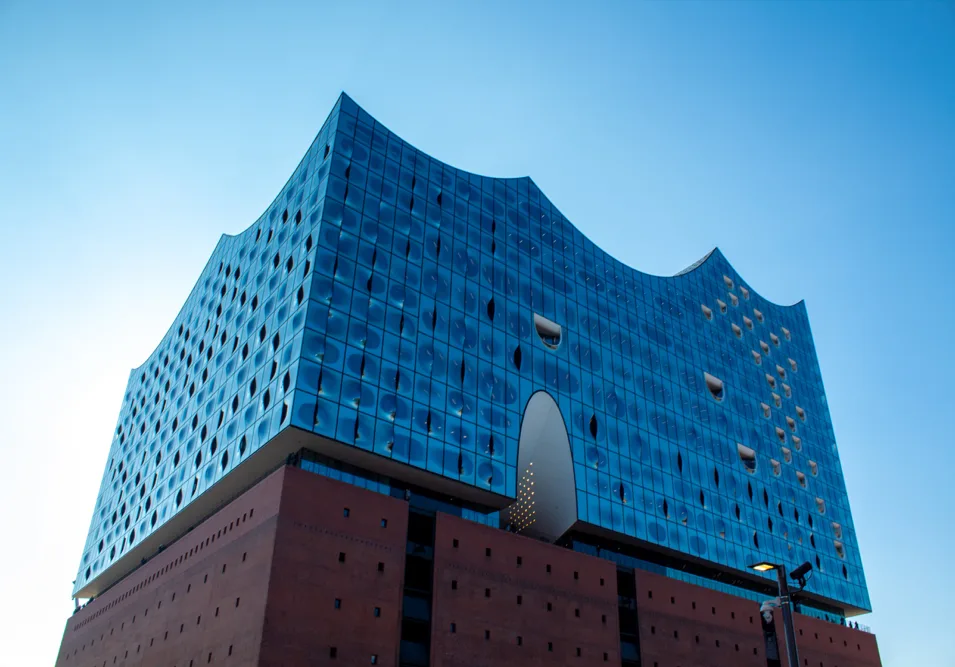
Hamburg
Compared to other German cities, Hamburg has a moody, nautical charisma all of its own. Despite being battered throughout history by floods, fires, and bombs, Hamburg has always held its head up high. Resilience is in the air in Hamburg, along with the briny smell of the North Sea. In recent years Hamburg has garnered a reputation for commerce and nightlife. Frequent travelers whisper that Hamburg is Germany’s ‘undiscovered’ city, the place to go for a little business and a lot of fun. Known as Germany’s ‘gateway to the world’, ships dock in Hamburg as they haul cargo up and down the Elbe River. The city thrives as Germany’s primary seaport and has been a center of trade since the middle ages. Its affluence shows in the 19th-century brick warehouses, flourishing restaurant scene, and recently constructed Elbphilharmonie concert hall, which floats majestically in the harbor, part ship and part island. Hamburg is a city for those who like to live large - in a cultured, German kind of way. Attend a performance at the orchestra, cruise on a boat around the Außenalster Lake, or have a night on the Reeperbahn, the Vegas-like strip where the Beatles once performed. Whatever you do in the city, Hamburg will make you look twice and see Germany from a totally different point of view.
Read More
Learn About Hamburg
Build Hamburg Trip
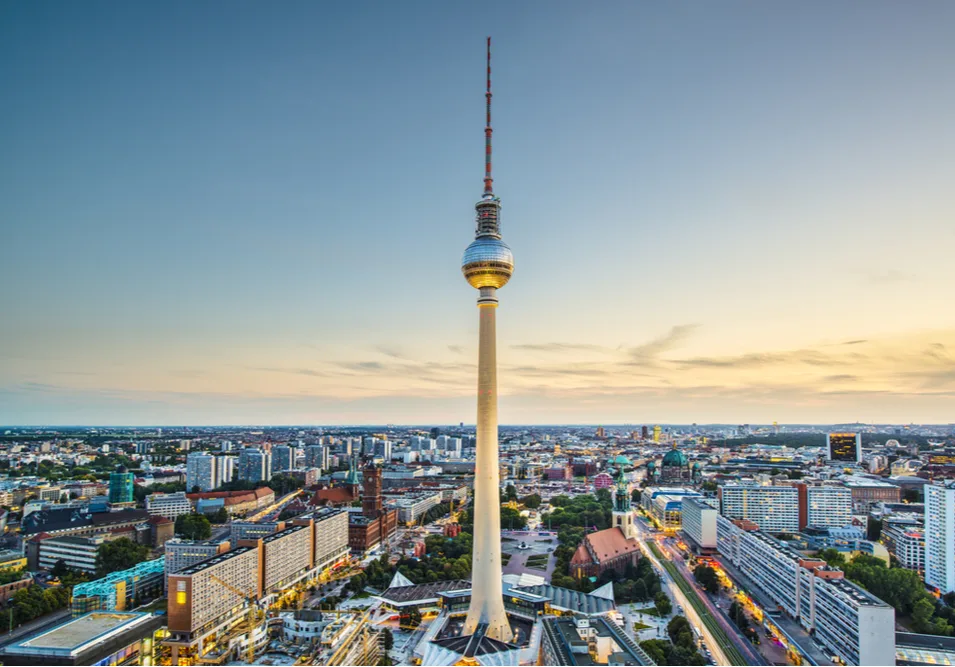
Berlin
Since the fall of its notorious wall, Berlin’s unification has seen it go from strength to strength. No wonder the city feels like it hasn’t stopped partying since the 1990s. There is so much to celebrate here. Fueled by the robust economy, a thriving tech scene, and straight-up German bonhomie, when you step into Berlin you’ll soon be caught up in its spirit. For all this gusto, Berlin hasn’t forgotten its troubled past. A visit to Berlin is to bear witness to history. Portions of the wall remain intact, and the city’s Jewish Museum offers a detailed, emotional examination of the Holocaust. Inside the reconstructed Reichstag, every attempt has been made to preserve the parliament’s beleaguered history. The buildings' glass dome addition feels less like a triumphal crown and more like a freshly healed battle scar. Days in Berlin are easily spent wandering from a cafe to the cultural institutions on Museum Island, or over to the Charlottenburg Palace. By night, crowds wander through the booming bars and nightclubs or gaze upon the floodlit Brandenburg Gate and Victory Column monuments. An international city that can offer something to everyone, Berlin is an unmissable stop on your German journey.
Read More
Learn About Berlin
Build Berlin Trip

Prague
The city of Prague is indisputably the gem of Central Europe. Full of history, culture, and classic Czech pubs around every corner, Prague is teeming with nooks and crannies just waiting to be discovered. The narrow cobblestone streets and warm red rooftops give the city a homey feel, while the well-preserved medieval architecture transports you back in time. Walking across the Charles Bridge with the view of the Prague Castle will make you feel like you’re living in a fairytale, and you might as well be. As an up-and-coming destination, Prague is a perfect mix of classic and modern. New trendy cafes and bistros are always popping up, and you can always find a group of lively locals chowing down on goulash and quaffing pivo (the best beer in Europe!) at traditional Czech restaurants across the city. The clash of modernity and tradition, preservation and innovation, gives this city a mysterious air that you won’t soon forget.
Read More
Learn About Prague
Build Prague Trip

Dresden
Nearly every wall and rooftop in Dresden seems to be finished with a flourish. Defined by its ornamental baroque architecture, a power statement of Saxon royalty, Dresden is made all the more miraculous considering the city was leveled by firebombing in WWII. After the war, the city was reconstructed, brick by painstaking brick. Even under East German-Soviet rule, which usually eschewed frivolous design, buildings like the Semper Opera House were pieced back to their former glory. Restoration of the majestic Zwinger Palace and bell domed Church of Our Lady slowly followed, with the Frauenkirche only fully repaired in 2005. Arguably there is no other city in Europe that cherishes its hard-won architecture as much as Dresden. Although it is a compact city, so many of its buildings will stop you in your tracks that architecture fans will easily lose a whole day in the Old Town area. Especially during the winter months, Dresden sparkles with a joyous, uplifting ambiance. The city is recognized as having the best-ever Christmas market in all of Europe. Between the twinkling lights, the scent of hot wine and gingerbread, and the towering Christmas tree, it’s worth going out of your way to see Dresden at this time of year.
Read More
Learn About Dresden
Build Dresden Trip

Nuremberg
One of the most authentic, storied German destinations, Nuremberg's picturesque old town, glorious castle, and buzzing Christmas Market makes this city a time-true classic. The ideal gateway to old Bavaria, Nuremberg offers a primer in German history before you embark on the lovely journey through old Bavaria, known as the Romantic Road. Considered the capital of the Holy Roman Empire in the middle ages, Nuremberg would have felt like the center of the world as a procession of kings and emperors passed through its magnificent gates. When the German Renaissance came, Nuremberg was at its heart. Albrecht Dürer, the great German master artist, was born here, and Martin Luther called Nuremberg Germany's 'eyes and ears'. Skip forward a few centuries, and the city took a dark turn, as Nuremberg became a gathering point for the German National Socialists. Slightly outside of town, you can still find the Nazi Party Rallying Grounds, a sobering reminder of the not so distant past. If it all gets too heavy, you can end the day with a glass of rotbier (red beer) and mull it over. Nuremberg is a must-see for anyone who wants to delve into Germany's past.
Read More
Learn About Nuremberg
Build Nuremberg Trip

Frankfurt
Dubbed ‘Mainhatten’ for its glass highrises, financial prowess, and proximity to the Main River, Frankfurt offers a fascinating glimpse into the ‘engine room’ of Europe’s economy with an unexpected twist. Among the glass and steel buildings, the old-worldly Römerberg square will give you a double-take. The square’s 15th-century half-timbered houses, old statues, and church spires contrast dramatically against the modern 21st-century skyscrapers beyond. If you visit at Christmas, the Römerberg is truly special, aglow with the light of the tallest Christmas tree in Germany. The square fills with stalls selling handicrafts, and the air is scented with hot apple wine, honey, and cinnamon. Delve deeper into Frankfurt and you’ll find a substantial museum district, the Museumsufer (Museum Embankment). This area features a cluster of twelve museums on either side of Main River. This includes the Städel, home to Tischbein’s famous painting of renowned writer Johann Wolfgang von Goethe, one of Frankfurt’s most prestigious sons. The more time you spend in Frankfurt, the more you’ll discover a highly cultured city lurking beneath its glass facades. If you have the time, Frankfurt is certainly worth a second look.
Read More
Learn About Frankfurt
Build Frankfurt Trip

Hamburg
Compared to other German cities, Hamburg has a moody, nautical charisma all of its own. Despite being battered throughout history by floods, fires, and bombs, Hamburg has always held its head up high. Resilience is in the air in Hamburg, along with the briny smell of the North Sea. In recent years Hamburg has garnered a reputation for commerce and nightlife. Frequent travelers whisper that Hamburg is Germany’s ‘undiscovered’ city, the place to go for a little business and a lot of fun. Known as Germany’s ‘gateway to the world’, ships dock in Hamburg as they haul cargo up and down the Elbe River. The city thrives as Germany’s primary seaport and has been a center of trade since the middle ages. Its affluence shows in the 19th-century brick warehouses, flourishing restaurant scene, and recently constructed Elbphilharmonie concert hall, which floats majestically in the harbor, part ship and part island. Hamburg is a city for those who like to live large - in a cultured, German kind of way. Attend a performance at the orchestra, cruise on a boat around the Außenalster Lake, or have a night on the Reeperbahn, the Vegas-like strip where the Beatles once performed. Whatever you do in the city, Hamburg will make you look twice and see Germany from a totally different point of view.
Read More
Learn About Hamburg
Build Hamburg Trip

Berlin
Since the fall of its notorious wall, Berlin’s unification has seen it go from strength to strength. No wonder the city feels like it hasn’t stopped partying since the 1990s. There is so much to celebrate here. Fueled by the robust economy, a thriving tech scene, and straight-up German bonhomie, when you step into Berlin you’ll soon be caught up in its spirit. For all this gusto, Berlin hasn’t forgotten its troubled past. A visit to Berlin is to bear witness to history. Portions of the wall remain intact, and the city’s Jewish Museum offers a detailed, emotional examination of the Holocaust. Inside the reconstructed Reichstag, every attempt has been made to preserve the parliament’s beleaguered history. The buildings' glass dome addition feels less like a triumphal crown and more like a freshly healed battle scar. Days in Berlin are easily spent wandering from a cafe to the cultural institutions on Museum Island, or over to the Charlottenburg Palace. By night, crowds wander through the booming bars and nightclubs or gaze upon the floodlit Brandenburg Gate and Victory Column monuments. An international city that can offer something to everyone, Berlin is an unmissable stop on your German journey.
Read More
Learn About Berlin
Build Berlin Trip

Prague
The city of Prague is indisputably the gem of Central Europe. Full of history, culture, and classic Czech pubs around every corner, Prague is teeming with nooks and crannies just waiting to be discovered. The narrow cobblestone streets and warm red rooftops give the city a homey feel, while the well-preserved medieval architecture transports you back in time. Walking across the Charles Bridge with the view of the Prague Castle will make you feel like you’re living in a fairytale, and you might as well be. As an up-and-coming destination, Prague is a perfect mix of classic and modern. New trendy cafes and bistros are always popping up, and you can always find a group of lively locals chowing down on goulash and quaffing pivo (the best beer in Europe!) at traditional Czech restaurants across the city. The clash of modernity and tradition, preservation and innovation, gives this city a mysterious air that you won’t soon forget.
Read More
Learn About Prague
Build Prague Trip

Dresden
Nearly every wall and rooftop in Dresden seems to be finished with a flourish. Defined by its ornamental baroque architecture, a power statement of Saxon royalty, Dresden is made all the more miraculous considering the city was leveled by firebombing in WWII. After the war, the city was reconstructed, brick by painstaking brick. Even under East German-Soviet rule, which usually eschewed frivolous design, buildings like the Semper Opera House were pieced back to their former glory. Restoration of the majestic Zwinger Palace and bell domed Church of Our Lady slowly followed, with the Frauenkirche only fully repaired in 2005. Arguably there is no other city in Europe that cherishes its hard-won architecture as much as Dresden. Although it is a compact city, so many of its buildings will stop you in your tracks that architecture fans will easily lose a whole day in the Old Town area. Especially during the winter months, Dresden sparkles with a joyous, uplifting ambiance. The city is recognized as having the best-ever Christmas market in all of Europe. Between the twinkling lights, the scent of hot wine and gingerbread, and the towering Christmas tree, it’s worth going out of your way to see Dresden at this time of year.
Read More
Learn About Dresden
Build Dresden Trip
prev
next


 Map of Your Itinerary Route
Map of Your Itinerary Route
Zoom In to the cities to see your itinerary in more detail


 4.8
4.8 







